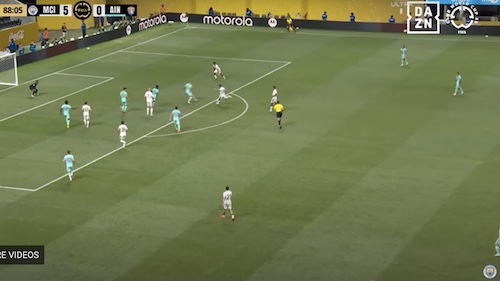|
by Bob Collins, Editor Student Athlete magazine You’re a High School student, more and more, you find yourself visualizing yourself at college. Each year another wave of graduates from your school departs for colleges in distant places. On holidays, when they return, as college students, they’re different … sure their caps and sweats proudly advertise their schools … but they also wear the self confidence of maturing young adults who have moved on to the next level in life. You are a little jealous and anxious to get there, too … here’s how to get accpeted at the college of your choice. As a student athlete and soccer player, you have to satisfy the same admission requirements as other students, but you have a very important friend, the college soccer coach. And depending upon how well you target "best fit" colleges, his/her influence on the acceptance decision can be very significant. Time for a Reality Check. Brutally assess your strengths, weaknesses and preferences. How do you learn? How easily do you learn? Do you prefer a structured or a free form setting? How important is playing time? How important is playing on a winning team? Would you stay on at the college if you could no longer play your sport? Which will be most important after college graduation … where you studied … what you studied … or who your classmates were? Remember, you must be brutally honest with yourself. For more information see "How To Choose the Right College For You," click on How To Pamphlets in dark blue margin to your left. Now that you have eliminated schools whose names would have impressed your friends, your High School teachers and you teammates … yet left you dreading every minute … you are ready to identify your "best fit" schools. Fact. Colleges sell education and you are the customer. They need student athletes who want to attend the college and play on the team … and are both academically and athletically qualified to do so. By selecting "best fit" schools you are doing a large part of the school’s work for them, so they will be very happy to hear from you. And the college’s actual "out of pocket" cost for a full scholarship is only about $1000 per year … primarily the food you eat in the cafeteria. All other costs are "fixed costs" that go on whether or not you attend the college. For more information click on Winning Your Scholarship book in dark blue margin to your left. Your High School Transcript – The best indications colleges have of how well you will do, is how well you have done in high school. Colleges pay attention to grades earned and courses taken starting in the 9th grade. They look for achievement in English, math, science, foreign language and history. The more credits and higher grades in these courses, the better. Is a B in a hard course better than an A in an easy course? Admissions Officers usually answer this by saying that tough academic courses are much better than frivolous ones and that grades in tough courses are given more weight than grades in easy ones. Stanford reminds its applicants: "Be careful not to assume that the world is divided between students who take difficult courses and get B’s and the students who take easy courses and get A’s. Most of our applicants are able to take the difficult courses and receive A’s." Of course not everyone wants to go to Stanford and not everyone can make straight A’s. If you can handle the work in honors, advanced placement (AP), or other accelerated courses, take at least a few of them. If it is obvious, from your transcript, that your are taking a lighter load than you can handle, they may question your motivation, especially if your work load and grades start dropping off in the 11th grade. Besides consistently high grades, nothing looks better than improving marks in your junior and senior years. The top candidates have taken AP courses like US History, Calculus, Chemistry, Physics and French IV. If you can handle them, do so. In addition to impressing admissions officers, you’ll be getting a better education. Here are some tips: English – If you want to go to a selective college, don’t take obviously easy courses like Sports Literature. If electives are offered pick courses that present you as a student with serious interest in literature and writing. Math – Taking math in your senior year is a good idea. But if math baffles you, don’t feel pressured to sign up for Calculus. Instead, choose Advanced Math or College Algebra, and they help on your SAT. If you will major in sciences or engineering, senior math is a must. History – It is somehow easier to find history electives that sound serious and interesting. Contemporary European History or the Russian Revolution won’t look bad on a transcript. Even better are non-Western European history electives. Foreign language – Taking three or more years of a foreign language is a great way to add seriousness to your transcript. Don’t make the mistake of taking one year of French, one year of Spanish and one year of German. A long term commitment to a language shows that you don’t mind studying and are willing to stick with your decision. It guarantees them a student with a deep knowledge of a language and that pleases foreign language professors. Your SAT score – The SAT is important, but nothing to be frightened of. The SAT and other standardized admissions tests play a big part in college admissions, and in some cases, in scholarships decisions. The SAT is a three hour, mostly multiple choice test, taken by 2 million students every year. Some public colleges put equal weight on math and verbal scores. Most other colleges weigh verbal more than math because professors are concerned about declining reading and writing skills. Ideally, you want scores to be good and close to each other. SAT is important because it is the only uniform number they have for all candidates. Fortunately, you can raise your SAT (or ACT) score with just a few months of work. For more information click on Winning Your Scholarship book in dark blue margin to your left. Your extracurricular category -Activities that you participate in after class make you different from everyone else. Colleges want students capable of doing college level work first and foremost. If those students also have personalities, that is a bonus! Quality is more important than quantity. Colleges are not impressed with one of everything on their application; better to be deeply involved with the same activities year after year. If you’ve been recognized and received and award, don’t be shy about it! Admissions officers are putting together well-rounded classes, and applicants who have focused on one particular pursuit, whether it is football or physics, are an integral part of the well-rounded class. If you can’t take part in extracurricular activities because you have to work after school, you are not at a disadvantage. Works builds character, among other things, so you should think about your job as and activity and use it to convey what a good college candidate you are. Beginning the process – Student athletes who read our publications and use our "Networking" will already know their target coaches very well by this point in time, and they will know a lot about their six "best fit" schools. For more information see "Networking The College Coach," click on How To Pamphlets in dark blue margin to your left. Early in your junior year, complete the NCAA Clearinghouse application and write to both the admissions office and the coach. When you receive application forms carefully compare them. Although they appear identical, the set from the coach may contain a code to signal a recruitable athlete. At U. Penn it is a large "A" screened in gray on the front page; at LSU the coach’s admission form is printed on purple paper. Even if you can’t see any difference, always use the set from your coach. For more information see "Think Like a College Coach While He’s Recruiting, click on How To Pamphlets in dark blue margin to your left. Your application essay – Some essay topics are assigned and some are left up to you. Approach finding a topic the same way you approach finding a college. Make a list of the personal characteristics you’d like to communicate, then choose an essay that most effectively communicates them. Admissions officers read some 30 per day, and are less bored by particulars. Narrow your focus and write about something that happened to you so the details stick in the reader’s mind. Most important. Essays must be structurally sound with no grammatical errors. Make sure your essay is perfect, no matter how unremarkable it may be otherwise. Your recommendations – Most colleges ask applicants to submit at least one recommendation from a teacher. Recommendations can have an important bearing on your admissions chances. Give your reference plenty of time and everything he needs, including a copy of your application, its deadline and a stamped addressed envelope. Pick a teacher who writes detailed and favorable comments on your papers. Set up an appointment to meet one-on-one. Think about what you want your reference to say and communicate those points in your meeting. During your meeting, discuss your past activities and future goals with your reference. Share the college’s admissions literature so that the reference has a sense of what the college is looking for in an applicant, especially if the school is unique. It is always good manners to thank the reference; sending a thank-you-note three weeks before the deadline will remind a forgetful teacher the papers in. Your admission interview – is less required today because of the increasing number of applicants. Some have networks of alumni who interview applicants. Learn the school’s practice before requesting one. Most interviews aren’t as important as students assume. Rarely does an interview ruin one’s chances, and only slightly more often does it put an applicant on top. Still it is a chance to make a good impression on the person who will read your application. Be prepared to answer – Why do you want to study here? What first brought us to your attention? What do you want to major in? What do you want to do with your life? Practice your answers with a friend or family member. Admissions officers prefer to meet you without your parents; during your interview Mom and Dad can meet with the Financial Aid Officer or the coach. Your official visit – student athletes are allowed five of these all- expense-paid trips. After July 1 (preceding your senior year) college coaches phone their top picks and begin to schedule these important visits. You will tour the campus, meet the team, see a game, stay overnight and receive the full sales pitch from everyone you meet. Be yourself and try to judge how happily you would fit into the group and its culture. Later, the coach will discuss your visit with those who met you, trying to judge your ability to contribute to his/her program. Scholarship discussions – usually will not be initiated by the coach until you have been accepted by the college. Most colleges will notify you of your acceptance promptly, but the very selective Ivy league and private colleges may delay until May of your senior year. This can make life very difficult for the player who receives an Official Athletic Scholarship Letter of Intent from Div I SMU in February (with a seven day expiration clause) and cannot have written confirmation of Princeton or U. Penn’s offers until May. For more information see "Compare scholarships, Grants and Aid at Division I, II, III and NAIA," click on How To Pamphlets in dark blue margin at your left. All coaches who recruit you will press for a decision on their offer, because they have a second and a third choice candidate waiting. Just before you decide, call each coach and honestly discuss the offers you have. If they can improve their offers, this is the time when it will happen. For more information see "Negotiate For Your Scholarship," click on How To Pamphlets in dark blue margin at your left. Electing Early Decision, while it improves your chances of acceptance by about 15%, is risky because it requires you to withdraw all other college applications and may significantly reduce your scholarship bargaining power. As in a close game, the last few minutes are heart stoppers; you’ll feel a lot better when you’ve made your decision. Soon it will be August and you’ll be off to preseason training as a college freshman! For more information see "Preparing For Your First Year In College" and "Stay On The Team And In College After You’ve Made It," click on How To Pamphlets in dark blue margin at your left. If you found this article useful, please subscribe to our magazine, The Student Athlete, and purchase our 3 books, 18 pamphlets and video which comprise our College Scholarships SYSTEM that has helped over 60,000 players. All are available now: Student Athlete.net
|
Your Soccer Resource Center















